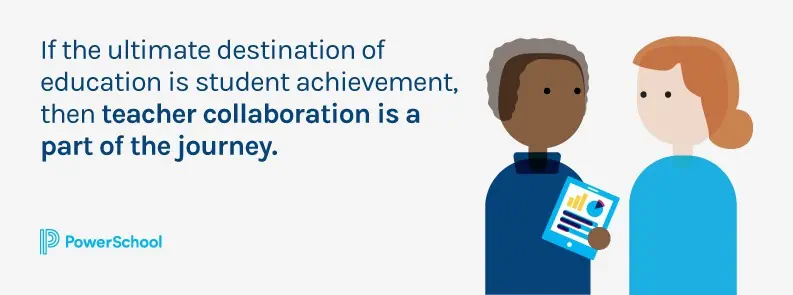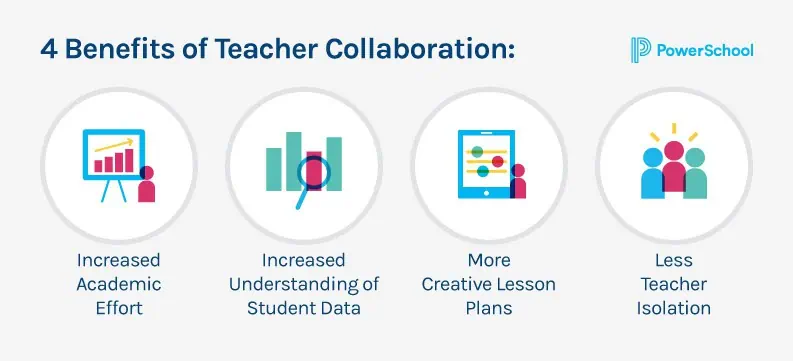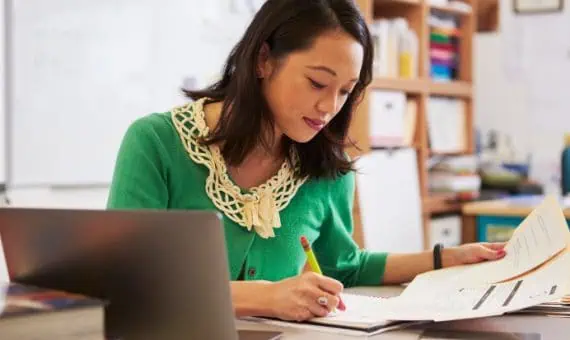Teacher collaboration is when educators work together to increase student learning. If the ultimate destination of education is student achievement, then teacher collaboration is a part of the journey.
Collaboration is not a task to complete and then move on—it’s an ever-changing process enhanced by social networks and access to cooperative spaces.
The beauty of collaboration is the ability to tap into various perspectives and ideas and the opportunity to share responsibility for our students’ learning. The more people invest in a student’s education, the better the student’s chance is to be successful.
Let’s take a deeper look into how teacher collaboration benefits everyone involved.
Benefits of Teacher Collaboration
When teachers come together to share information, resources, ideas, and expertise, learning becomes more accessible and effective for students. Collaborating means purposefully building interpersonal relationships and working towards healthy interdependence once teachers feel comfortable giving and receiving help while maintaining accountability.
When teachers co-plan and co-teach based on a shared vision, everyone benefits from:
- Increased Academic Effort—Since teachers who collaborate on instruction are all on the same page, they can increase academic rigor to match the core competencies they want students to meet.
- Increased Understanding of Student Data—Teachers are better equipped to deconstruct relevant data and implement practical formative and summative assessments when they collaborate. They also have a sense of shared responsibility for celebrating success and analyzing lessons from failure.
- More Creative Lesson Plans— When teachers communicate and share ideas, they can share a more extensive instructional strategy toolbox that encourages creative instruction. This could also influence other teachers to try different approaches or have opportunities to help a peer experiment with a new approach.
- Less Teacher Isolation—Having the opportunity to share ideas and information combats professional loneliness and frustration, which improves staff morale and professional satisfaction.
The benefits of teacher collaboration are present in learning communities worldwide. The key is acknowledging, understanding, and working diligently to overcome the challenges and obstacles standing in the way of high-quality teacher collaboration.
Challenges of Effective Teacher Collaboration
For many schools, teacher collaboration is unchartered territory, making working together unstructured and inconsistent. The most common challenges of high-quality, effective teacher collaboration include:
- Lack of a True Professional Learning Community (PLC)—PLCs are a powerful tool in education and school reform. Teacher collaboration can seem forced and challenging without a commitment to the PLC process.
- Lack of Planning, Collaboration, or Reflection Time—Many teachers and administrators feel like there are not enough hours in the school day. Without planning time embedded in their daily teaching responsibilities, teachers could lose a valuable resource.
- Lack of Conflict Resolution—Collaborative groups are often comprised of multiple personalities and perspectives which could lead to unproductive experiences if there isn’t an effective process for conflict resolution.
The Role of Technology in Teacher Collaboration
PLCs and professional learning networks (PLNs) are extremely effective teacher collaboration methods that directly influence student engagement and achievement, as well as growth for the educators who work with them.
Technology plays a major role in modern teacher collaboration. Actively participating in a PLN on a social network gives you direct access to the knowledge, experience, and resources of countless educators you may have never connected within your immediate professional circles.
Also, don’t forget about the built-in capabilities of your district’s learning management system (LMS). You may already have the tools to connect with colleagues and share ideas in an online community unique to your district or school. Ideally, your LMS has the communication and sharing tools you need, making it the perfect place to create common assessments, track student data, share resources, and keep assignments. Plus, it provides a safe space for online collaboration for students and staff.
If you’re part of a PLC school where educators gather regularly for in-person collaborative sessions, technology can still be a high quality, supporting tool. Access to your LMS in these meetings gives you a place to create instructional content, store lesson plans and resources, and analyze student data—with the added benefit of in-person collaboration.
Video technology is a valuable tool as well. Record lessons to use for professional development and coaching in collaborative meetings. Or meet with teams of teachers on other campuses via video chat applications like Google Hangouts or Zoom.
However you choose to collaborate, take note of these effective strategies below to get the most out of your efforts.
Effective Teacher Collaboration Strategies
For teacher collaboration to be effective, teachers should want to participate rather than feel like they must. Like any other skill, collaboration can be honed and improved upon with practice. Here are a few strategies to set the stage for successful, high-quality teacher collaboration:
Develop and Agree Upon a Shared Vision and Mutual Goals
A teacher’s ownership of the collaborative process can determine how much time and energy they put into collaborating. Having a shared vision and mutual goals can encourage a genuine sense of ownership.
For example, if your team identifies that it is committed to building relationships with students and student learning, set goals related to that vision, discuss how to reach those goals, and assess progress and alignment regularly.
Encourage a Sense of Community
Collaboration is all about building relationships. Taking the time to get to know colleagues and relate personally can help teachers develop a greater sense of respect and trust for one another. Like any relationship, collaborative teams take time to build and have the potential to increase in strength and productivity over time.
Establish Group Norms and Expectations
Of course, collaboration can be stressful and even uncomfortable at times. It’s important to develop a culture of trust, respect, and humility for everyone to thrive. Delegating roles and responsibilities, protocols for communication, and time management can also help establish group norms and expectations.
Leverage Discussion to Work Through Conflicts
Dialogue can lead to deep professional learning for educators as they explore new ideas for teaching. Dialogue requires active listening, a willingness to share ideas, and a belief in the power of communication.
Discussion is made up of dialogue with the intention of building consensus or making decisions. Although conversation opens doors to new possibilities, it can also open the door to conflict. So, it’s a good idea to develop a conflict management plan, encourage teacher social and emotional learning, and always use professional judgment.
Collaboration Benefits Teachers and Students
Strong collaborative cultures develop over time and require effort and commitment to the process. While the benefits are undeniable, true collaboration is complex. Common planning time, PLCs, and PLNs are all effective methods of teacher collaboration.
With time, teachers can develop genuine collaborative teams in which they share goals, engage in mutually beneficial professional learning, use shared resources to increase student achievement, and advance their skills, knowledge, and beliefs about student learning.
PowerSchool Has Integrated the Classroom to Simplify Teaching and Learning
PowerSchool's classroom products have integrated K-12 classroom technology tools to enhance teaching and learning and encourage teacher collaboration.
Read the Blog




